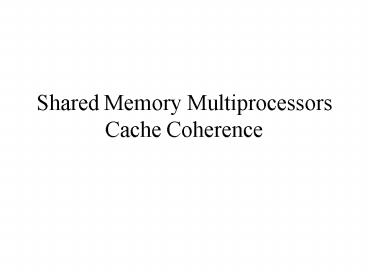Shared Memory Multiprocessors Cache Coherence PowerPoint PPT Presentation
1 / 25
Title: Shared Memory Multiprocessors Cache Coherence
1
Shared Memory MultiprocessorsCache Coherence
2
SMP hardware organization
3
- SMP systems support shared memory abstraction
all processors see the whole memory and can
perform memory operations on all memory
locations. - Two key issues in such an architecture
- Cache coherence
- Memory consistency model formal specification of
memory semantics - The model affects many hardware and software
optimization techniques. - Cache coherence is a part that defines the
consistency model.
4
Cache coherence problem
- Due to the cache copies of the memory, different
processors may see the different values of the
same memory location. - Processors see different values for u after
event 3. - With a write-back cache, memory may store the
stale date. - Unacceptable to programs and happens frequently.
5
Bus Snoopy Cache Coherence protocols
- Memory centralized with uniform access time and
bus interconnect. - Example All Intel MP machines like diablo
6
Bus Snooping idea
- Send all requests for data to all processors
- Processors snoop to see if they have a copy and
respond accordingly. - Requires broadcast since caching information is
at processors. - Bus is a natural broadcast medium.
- Bus (centralized medium) also serializes
requests. - Dominates small scale machines.
7
Types of snoopy bus protocols
- Write invalidate protocols
- Write to shared data an invalidate is sent to
all caches which snoop and invalidate copies. - Read miss
- Write-through memory is always up-to-date
- Write-back snoop in caches to find most recent
copy - Write broadcast protocols (typically write
through) - Write to shared data broadcast on bus,
processors snoop and update any copies. - Read miss memory is always up to date.
8
An Example Snoopy Protocol (MSI)
- Invalidation protocol, write-back cache
- Each block of memory is in one state
- Clean in all caches and up-to-date in memory
(shared) - Dirty in exactly one cache (exclusive)
- Not in any cache
- Each cache block is in one state
- Shared block can be read
- Exclusive cache has only copy, its writable and
dirty - Invalid block contains no data.
- Read misses cause all caches to snoop bus
- Write to a shared block is treated as misses
(needs bus transaction).
9
MSI protocol state machine for CPU requests
10
MSI protocol state machine for Bus requests
11
MSI protocol state machine (combined)
12
(No Transcript)
13
(No Transcript)
14
(No Transcript)
15
(No Transcript)
16
(No Transcript)
17
(No Transcript)
18
Some snooping cache variations
- Basic Protocol
- Three states MSI.
- Can optimize by refining the states so as to
reduce the transactions in some cases. - Berkeley protocol
- Five states, M ? owned, exclusive, owned shared.
- Illinois protocols (five states)
- MESI protocol (four states)
- M ? modified and Exclusive.
- Used by Intel MP systems.
19
Multiple levels of caches
- Most processors today have on-chip L1 and L2
caches. - Transactions on L1 cache are not visible to bus
(needs separate snooper for coherence, which
would be expensive). - Typical solution
- Maintain inclusion property on L1 and L2 cache so
that all bus transactions that are relevant to L1
are also relevant to L2 sufficient to only use
the L2 controller to snoop the bus. - Propagating transactions for coherence in the
hierarchy.
20
Large share memory multiprocessors
- The interconnection network is usually not a
bus. - No broadcast medium ? cannot snoop.
- Needs a different kind of cache coherence
protocol.
21
Cache coherence for large SMPs
- Use a directory for each cache line to track the
state of every block in the cache. - Can also track the state for all memory blocks ?
directory size O(memory size). - Need to used distributed directory
- Centralized directory becomes the bottleneck.
- Typically called cc-NUMA mulriprocessors
22
ccNUMA multiprocessors
23
Directory based cache coherence protocols
- Similar to snoopy protocol three states
- Shared gt 1 processors have the data, memory
up-to-date - Uncached not valid in any cache
- Exclusive 1 processor has data, memory
out-of-date - Directory must track
- Cache state
- Which processors have data when it is in shared
state - Bit vector, 1 if a particular processor has a
copy - Id and bit vector combination
- Keep it simple
- Writes to non-exclusive data ? write miss
- Processor blocks until access completes
- Assume messages received and acted upon in the
order of send
24
Directory based cache coherence protocols
- No bus and do not want to broadcast
- Typically 3 processors involved
- Local node where a request originates
- Home node where the memory location of an address
resides - Remote node has a copy a cache block (exclusive
or shared)
25
Directory protocol messages example

